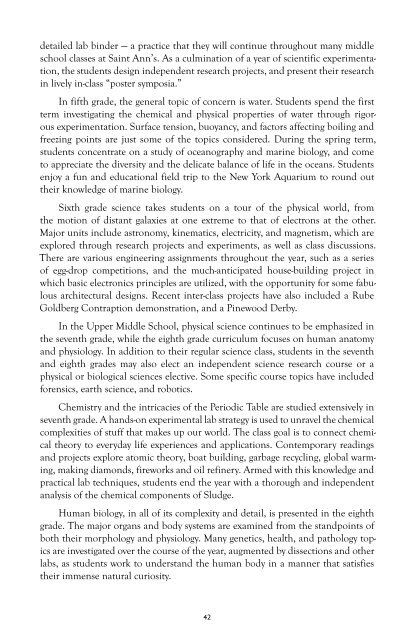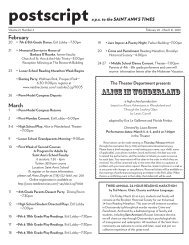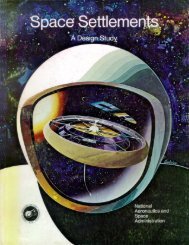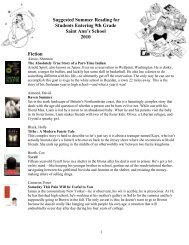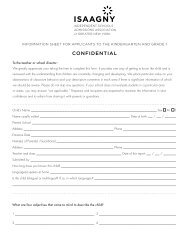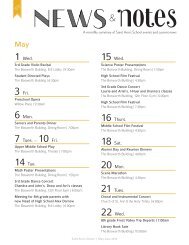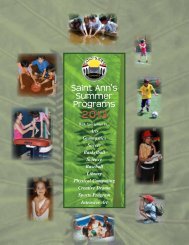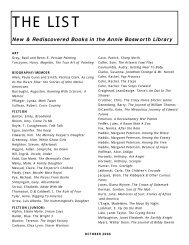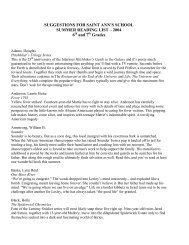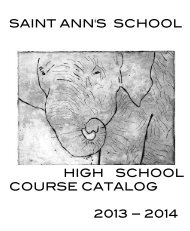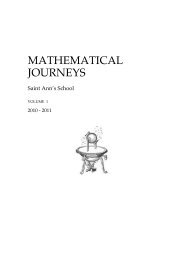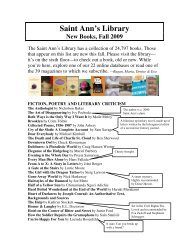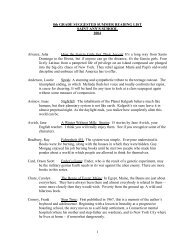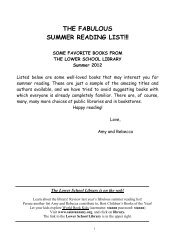Saint Ann's School Curriculum - An Overview
Saint Ann's School Curriculum - An Overview
Saint Ann's School Curriculum - An Overview
Create successful ePaper yourself
Turn your PDF publications into a flip-book with our unique Google optimized e-Paper software.
detailed lab binder — a practice that they will continue throughout many middle<br />
school classes at <strong>Saint</strong> <strong>An</strong>n’s. As a culmination of a year of scientific experimentation,<br />
the students design independent research projects, and present their research<br />
in lively in-class “poster symposia.”<br />
In fifth grade, the general topic of concern is water. Students spend the first<br />
term investigating the chemical and physical properties of water through rigorous<br />
experimentation. Surface tension, buoyancy, and factors affecting boiling and<br />
freezing points are just some of the topics considered. During the spring term,<br />
students concentrate on a study of oceanography and marine biology, and come<br />
to appreciate the diversity and the delicate balance of life in the oceans. Students<br />
enjoy a fun and educational field trip to the New York Aquarium to round out<br />
their knowledge of marine biology.<br />
Sixth grade science takes students on a tour of the physical world, from<br />
the motion of distant galaxies at one extreme to that of electrons at the other.<br />
Major units include astronomy, kinematics, electricity, and magnetism, which are<br />
explored through research projects and experiments, as well as class discussions.<br />
There are various engineering assignments throughout the year, such as a series<br />
of egg-drop competitions, and the much-anticipated house-building project in<br />
which basic electronics principles are utilized, with the opportunity for some fabulous<br />
architectural designs. Recent inter-class projects have also included a Rube<br />
Goldberg Contraption demonstration, and a Pinewood Derby.<br />
In the Upper Middle <strong>School</strong>, physical science continues to be emphasized in<br />
the seventh grade, while the eighth grade curriculum focuses on human anatomy<br />
and physiology. In addition to their regular science class, students in the seventh<br />
and eighth grades may also elect an independent science research course or a<br />
physical or biological sciences elective. Some specific course topics have included<br />
forensics, earth science, and robotics.<br />
Chemistry and the intricacies of the Periodic Table are studied extensively in<br />
seventh grade. A hands-on experimental lab strategy is used to unravel the chemical<br />
complexities of stuff that makes up our world. The class goal is to connect chemical<br />
theory to everyday life experiences and applications. Contemporary readings<br />
and projects explore atomic theory, boat building, garbage recycling, global warming,<br />
making diamonds, fireworks and oil refinery. Armed with this knowledge and<br />
practical lab techniques, students end the year with a thorough and independent<br />
analysis of the chemical components of Sludge.<br />
Human biology, in all of its complexity and detail, is presented in the eighth<br />
grade. The major organs and body systems are examined from the standpoints of<br />
both their morphology and physiology. Many genetics, health, and pathology topics<br />
are investigated over the course of the year, augmented by dissections and other<br />
labs, as students work to understand the human body in a manner that satisfies<br />
their immense natural curiosity.<br />
In high school, students take a<br />
minimum of three years of science,<br />
one of which is general biology and<br />
at least one of which is a physical science<br />
course. Most students, however,<br />
take at least four full-year science<br />
courses, and many take more than<br />
one each year. The comprehensive<br />
biology course is generally taken by<br />
ninth graders, who then spend the<br />
year in rigorous investigation of the<br />
living world from molecules to cells to entire ecosystems, studying cellular respiration,<br />
mitosis and meiosis, genetics, plant biology, taxonomy, and animal behavior,<br />
among other topics, with evolution serving as a unifying theme. Students work<br />
with microscopes and are introduced to the fundamental lab techniques of molecular<br />
biology and modern genetics.<br />
In the tenth grade and beyond, students may choose from among any of the<br />
offered electives. All students are strongly encouraged to take both chemistry and<br />
physics early in their high school career, as these courses often are prerequisite<br />
for advanced study in the sciences. The department offers advanced second-year<br />
classes in biology, chemistry, and physics, and a wide array of electives in each of<br />
these disciplines as well. Elective courses vary from year to year, depending on student<br />
interest and faculty expertise. They may be either one or two semesters long<br />
and differ in their level of difficulty. Recently offered electives include <strong>An</strong>imal<br />
Behavior; Applied Topics in Chemistry: Forensics; Organic Chemistry; Human<br />
Health and Disease; Genetics; Meteorology; Microbiology; Marine Biology, Mind<br />
in the Universe; Nutrition; Classical Mechanics and Relativity; and Robotics.<br />
Our high school independent research program provides an additional opportunity<br />
for students to choose their own paths of scientific exploration. Individual<br />
students or groups of students seek out science faculty advisers with a particular<br />
area of expertise to guide them. The topic and pace of the research is set by student<br />
motivation, ability, and time constraints. Research students attend scientific lectures<br />
and exhibit their findings at our creative in-house Science Symposium held<br />
annually at the end of May. Students occasionally participate in outside research<br />
or academic programs, and competitions such as the New York City Science<br />
and Engineering Fair. Our department has also had a very successful marine science<br />
trivia team participate in the NOSB regional Bay Scallop Bowl for the last<br />
many years.<br />
42 43


